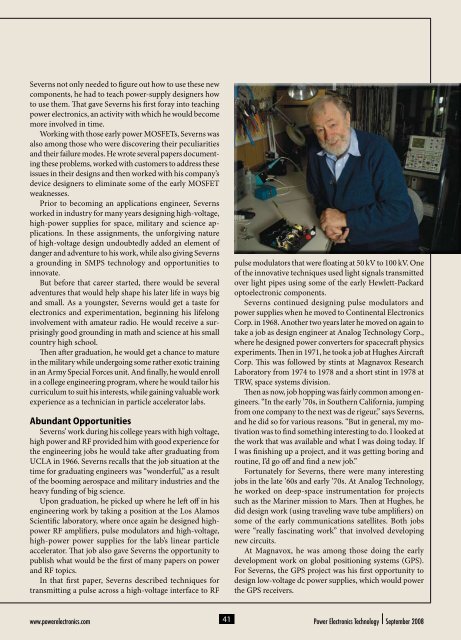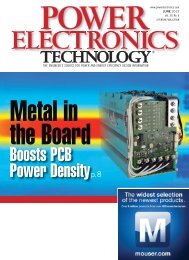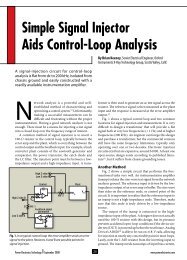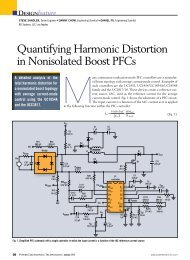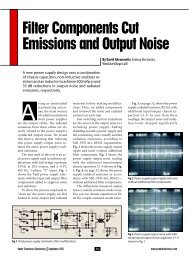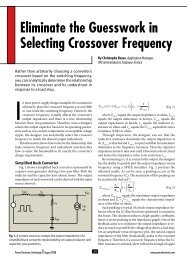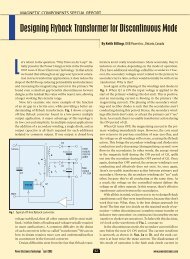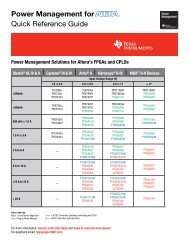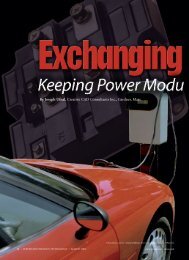Rudy SeveRnS - Power Electronics
Rudy SeveRnS - Power Electronics
Rudy SeveRnS - Power Electronics
Create successful ePaper yourself
Turn your PDF publications into a flip-book with our unique Google optimized e-Paper software.
Severns not only needed to figure out how to use these new<br />
components, he had to teach power-supply designers how<br />
to use them. That gave Severns his first foray into teaching<br />
power electronics, an activity with which he would become<br />
more involved in time.<br />
Working with those early power MOSFETs, Severns was<br />
also among those who were discovering their peculiarities<br />
and their failure modes. He wrote several papers documenting<br />
these problems, worked with customers to address these<br />
issues in their designs and then worked with his company’s<br />
device designers to eliminate some of the early MOSFET<br />
weaknesses.<br />
Prior to becoming an applications engineer, Severns<br />
worked in industry for many years designing high-voltage,<br />
high-power supplies for space, military and science applications.<br />
In these assignments, the unforgiving nature<br />
of high-voltage design undoubtedly added an element of<br />
danger and adventure to his work, while also giving Severns<br />
a grounding in SMPS technology and opportunities to<br />
innovate.<br />
But before that career started, there would be several<br />
adventures that would help shape his later life in ways big<br />
and small. As a youngster, Severns would get a taste for<br />
electronics and experimentation, beginning his lifelong<br />
involvement with amateur radio. He would receive a surprisingly<br />
good grounding in math and science at his small<br />
country high school.<br />
Then after graduation, he would get a chance to mature<br />
in the military while undergoing some rather exotic training<br />
in an Army Special Forces unit. And finally, he would enroll<br />
in a college engineering program, where he would tailor his<br />
curriculum to suit his interests, while gaining valuable work<br />
experience as a technician in particle accelerator labs.<br />
Abundant Opportunities<br />
Severns’ work during his college years with high voltage,<br />
high power and RF provided him with good experience for<br />
the engineering jobs he would take after graduating from<br />
UCLA in 1966. Severns recalls that the job situation at the<br />
time for graduating engineers was “wonderful,” as a result<br />
of the booming aerospace and military industries and the<br />
heavy funding of big science.<br />
Upon graduation, he picked up where he left off in his<br />
engineering work by taking a position at the Los Alamos<br />
Scientific laboratory, where once again he designed highpower<br />
RF amplifiers, pulse modulators and high-voltage,<br />
high-power power supplies for the lab’s linear particle<br />
accelerator. That job also gave Severns the opportunity to<br />
publish what would be the first of many papers on power<br />
and RF topics.<br />
In that first paper, Severns described techniques for<br />
transmitting a pulse across a high-voltage interface to RF<br />
pulse modulators that were floating at 50 kV to 100 kV. One<br />
of the innovative techniques used light signals transmitted<br />
over light pipes using some of the early Hewlett-Packard<br />
optoelectronic components.<br />
Severns continued designing pulse modulators and<br />
power supplies when he moved to Continental <strong>Electronics</strong><br />
Corp. in 1968. Another two years later he moved on again to<br />
take a job as design engineer at Analog Technology Corp.,<br />
where he designed power converters for spacecraft physics<br />
experiments. Then in 1971, he took a job at Hughes Aircraft<br />
Corp. This was followed by stints at Magnavox Research<br />
Laboratory from 1974 to 1978 and a short stint in 1978 at<br />
TRW, space systems division.<br />
Then as now, job hopping was fairly common among engineers.<br />
“In the early ’70s, in Southern California, jumping<br />
from one company to the next was de rigeur,” says Severns,<br />
and he did so for various reasons. “But in general, my motivation<br />
was to find something interesting to do. I looked at<br />
the work that was available and what I was doing today. If<br />
I was finishing up a project, and it was getting boring and<br />
routine, I’d go off and find a new job.”<br />
Fortunately for Severns, there were many interesting<br />
jobs in the late ’60s and early ’70s. At Analog Technology,<br />
he worked on deep-space instrumentation for projects<br />
such as the Mariner mission to Mars. Then at Hughes, he<br />
did design work (using traveling wave tube amplifiers) on<br />
some of the early communications satellites. Both jobs<br />
were “really fascinating work” that involved developing<br />
new circuits.<br />
At Magnavox, he was among those doing the early<br />
development work on global positioning systems (GPS).<br />
For Severns, the GPS project was his first opportunity to<br />
design low-voltage dc power supplies, which would power<br />
the GPS receivers.<br />
www.powerelectronics.com 41<br />
<strong>Power</strong> <strong>Electronics</strong> Technology September 2008


